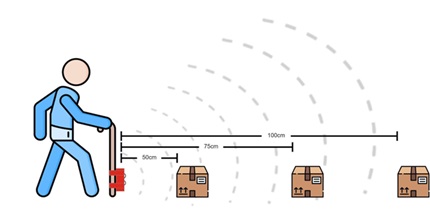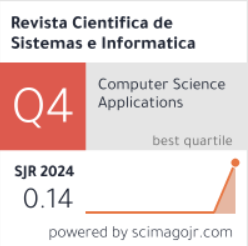Innovación inclusiva: Implementación de sensores de proximidad de bajo costo para bastones
DOI:
https://doi.org/10.51252/rcsi.v5i1.838Palabras clave:
autonomía, accesibilidad, ultrasónico, IoT, microcontroladoresResumen
Las personas con discapacidad visual enfrentan dificultades para desplazarse de manera segura, lo que afecta su independencia y aumenta el riesgo de accidentes. Este trabajo presenta el desarrollo de un prototipo de accesorio para bastones con sensores ultrasónicos, diseñado para mejorar la movilidad e independencia de estas personas a un bajo costo. El dispositivo, basado en IoT, emplea un Arduino Nano, un sensor ultrasónico HC-SR04 y un buzzer, generando alertas acústicas progresivas según la proximidad de los obstáculos. Durante las pruebas, demostró alta efectividad en la detección de objetos grandes y en la emisión de alertas inmediatas; sin embargo, presentó limitaciones con objetos pequeños, líquidos y en entornos húmedos. Se identificó la necesidad de optimizar la batería, actualmente reemplazable, y se propuso como mejora futura la incorporación de tecnologías de carga inalámbrica y sensores LIDAR para una detección más precisa. Además, se recomendó incluir un LED nocturno para alertar a otras personas y mejorar los materiales del bastón para aumentar su durabilidad. El diseño del prototipo es ligero, accesible y funcional, priorizando la simplicidad sin comprometer la confiabilidad. En comparación con dispositivos similares, destaca por su efectividad y bajo costo, ofreciendo una solución viable para mejorar la movilidad e independencia de personas con discapacidad visual, reduciendo riesgos y facilitando su integración social.
Descargas
Citas
Bansal, M., Malik, S., Kumar, M., & Meena, N. (2020). Arduino based Smart Walking Cane for Visually Impaired People. 2020 Fourth International Conference on Inventive Systems and Control (ICISC), 462–465. https://doi.org/10.1109/ICISC47916.2020.9171209
Choe, S., Cha, S.-Y., Cheon, D., Kwak, S.-B., & Kim, H.-S. (2023). Smart Cane Using Time-Division Overlapped-Beam Based Multi-Ultrasonic Sensors. The Journal of Korean Institute of Communications and Information Sciences, 48(9), 1091–1101. DBpia. https://doi.org/10.7840/kics.2023.48.9.1091
Díaz Alva, A. (2023). Bastón inteligente: Innovación inclusiva. Willachikuy, 3(2), 3–4. https://doi.org/10.46363/willachikuy.v3i2.2
Gharghan, S. K., Kamel, H. S., Marir, A. A., & Saleh, L. A. (2024). Smart Stick Navigation System for Visually Impaired Based on Machine Learning Algorithms Using Sensors Data. Journal of Sensor and Actuator Networks, 13(4). https://doi.org/10.3390/jsan13040043
Harini, A., Buvana, C., Harshini, M., Keerthana, S., Prabhu, D., & Umamaheswaran, S. K. (2024). Iot Based Smart Assistant Cane For The Visually Impaired. 2024 International Conference on Communication, Computing and Internet of Things (IC3IoT), 1–6. https://doi.org/10.1109/IC3IoT60841.2024.10550222
Jang, D.-K., Yang, D., Jang, D.-Y., Choi, B., Lee, S.-H., & Shin, D. (2024). ELMO: Enhanced Real-time LiDAR Motion Capture through Upsampling. ACM Transactions on Graphics, 43(6). https://doi.org/10.1145/3687991
Leporini, B., Raucci, M., Rosellini, M., & Forgione, N. (2023). Towards a Haptic-based Virtual Cane to Assist Blind People in Obstacle Detection. Proceedings of the 16th International Conference on PErvasive Technologies Related to Assistive Environments, 10–13. https://doi.org/10.1145/3594806.3594864
Ma, Z., Wang, S., Ma, Z., Li, J., Zhao, L., Li, Z., Wang, S., Shuang, Y., Wang, J., Wang, F., Xia, W., Jian, J., He, Y., Wang, J., Guo, P., & Wang, H. (2024). Efficient and Stable Photoassisted Lithium-Ion Battery Enabled by Photocathode with Synergistically Boosted Carriers Dynamics. Nano-Micro Letters, 17(1), 74. https://doi.org/10.1007/s40820-024-01570-7
Mai, C., Chen, H., Zeng, L., Li, Z., Liu, G., Qiao, Z., Qu, Y., Li, L., & Li, L. (2024). A Smart Cane Based on 2D LiDAR and RGB-D Camera Sensor-Realizing Navigation and Obstacle Recognition. Sensors, 24(3). https://doi.org/10.3390/s24030870
Minatani, K. (2024). Proposal for a Versatile Smart White Cane Infrastructure Using a 3D Printer: As a R&D Platform and a Practical Product Design. Proceedings of the 17th International Conference on PErvasive Technologies Related to Assistive Environments, 21–26. https://doi.org/10.1145/3652037.3652064
Mocanu, A., Sita, V., Avram, C., & Aştilean, A. (2024). Enhanced Cane for Blind People Mobility Assistance. 2024 IEEE International Conference on Automation, Quality and Testing, Robotics (AQTR), 1–6. https://doi.org/10.1109/AQTR61889.2024.10554132
Muktha., D. S., Niveditha, G., Pinto, N. A., & Sinha, S. (2024). Enhancing Mobility: A Smart Cane with Integrated Navigation System and Voice-Assisted Guidance for the Visually Impaired. 2024 IEEE 13th International Conference on Communication Systems and Network Technologies (CSNT), 1124–1129. https://doi.org/10.1109/CSNT60213.2024.10546111
Nazri, N. M. A., Fauzi, S. S. M., Gining, R. A. J., Razak, T. R., & Jamaluddin, M. N. F. (2020). Smart Cane for Visually Impaired with Obstacle, Water Detection and GPS. International Journal of Computing and Digital Systems. https://api.semanticscholar.org/CorpusID:222078779
Panazan, C.-E., & Dulf, E.-H. (2024). Intelligent Cane for Assisting the Visually Impaired. Technologies, 12(6). https://doi.org/10.3390/technologies12060075
Paredes Orozco, D. L., & Domínguez-Morales, M. (2024). Smart Cane for the Visually Impaired. In Y. Torres, A. M. Beltran, M. Felix, E. Peralta, & D. F. Larios (Eds.), Recent Advances and Emerging Challenges in STEM (pp. 451–460). Springer Nature Switzerland.
Remya, V., Subramani, S., Gokulnaath, M., Sibiraj, T., Priyan, T., & Rajalakshmi, S. (2023). Smart Walking Cane for Navigation of Visually Impaired. 2023 Intelligent Computing and Control for Engineering and Business Systems (ICCEBS), 1–4. https://doi.org/10.1109/ICCEBS58601.2023.10448603
Romeo, N. K., Rajbanshi, S., Lukama, W., Kaur, M., Rakesh, N., & Goyal, M. K. (2022). Design a Smart Cane for Visually Impaired Individuals’ Assistance. 2022 International Conference on Fourth Industrial Revolution Based Technology and Practices (ICFIRTP), 295–296. https://doi.org/10.1109/ICFIRTP56122.2022.10063212
Song, H., Panda, S., Hajra, S., Hwang, S., Jo, J., Kim, N., Panigrahi, B. K., Yu, J., Jeong, S. M., & Kim, H. J. (2024). A Self-Powered Smart White Cane for Improving Mobility of Visually Impaired Person Using a Triboelectric Nanogenerator. Energy Technology, 12(7), 2400424. https://doi.org/10.1002/ente.202400424
Trujillo Mora, V., González Jaimes, E. I., López Chau, A., & Bautista López, J. (2021). Analysis of the usefulness of the UAEM Smart White Cane for people with visual impairment. RIDE. Revista Iberoamericana Para La Investigación y El Desarrollo Educativo, 11(22). https://doi.org/10.23913/ride.v11i22.897
Ulfa, A., Rosspertiwi, A. A., Sahroni, A., & Murnani, S. (2023). S-Cane: Ultrasonic Sensor-Based Smart Cane for the Visually Impaired. 2023 IEEE International Biomedical Instrumentation and Technology Conference (IBITeC), 7–11. https://doi.org/10.1109/IBITeC59006.2023.10390939
Venkatraman, S., Subramanian, K., Tolia, C., & Shanbhag, R. (2020). Smart Cane-An Aid for the Visually Challenged. In J. S. Raj, A. Bashar, & S. R. J. Ramson (Eds.), Innovative Data Communication Technologies and Application (pp. 692–701). Springer International Publishing.
Vineeth, I., Sharan, Y. H. V. S., Karthik, Y., & Priya, B. K. (2021). Smart Cane for Visually Impaired Person. 2021 International Conference on Intelligent Technologies (CONIT), 1–6. https://doi.org/10.1109/CONIT51480.2021.9498563
Yam, B., & Elshakankiri, M. (2024). The Design of Smart Cane SC+. In A. K. Nagar, D. S. Jat, D. Mishra, & A. Joshi (Eds.), Intelligent Sustainable Systems (pp. 461–470). Springer Nature Singapore.
Yauri, R., Alvarez, K., Cotaquispe, J., Ynquilla, J., & Llerena, O. (2024). Guidance device for visually impaired people based on ultrasonic signals and open hardware. International Journal of Reconfigurable and Embedded Systems, 13(3), 520–527. https://doi.org/10.11591/ijres.v13.i3.pp520-527
Zaidi, S. F. N., Shukla, V. K., Gupta, S., & Preetha, V. K. (2023). Enhancing Access of the Visually Impaired Through the Smart Cane. In S. Vyas, A. Upadhyaya, D. Bhargava, & V. K. Shukla (Eds.), Edge-AI in Healthcare: Trends and Future Perspectives (pp. 65–78). CRC Press. https://doi.org/10.1201/9781003244592-5

Descargas
Publicado
Cómo citar
Número
Sección
Licencia
Derechos de autor 2025 Herald Gonzales-Saavedra, Kenjy Garcia-Hurtado, Carlos Gallegos-Pinedo, Rodrigo Tenazoa-Bardales, Anthony Ordinola-Sinarahua, Diego Hilario-Putpaña, Dick Diaz-Delgado

Esta obra está bajo una licencia internacional Creative Commons Atribución 4.0.
Los autores retienen sus derechos:
a. Los autores retienen sus derechos de marca y patente, y tambien sobre cualquier proceso o procedimiento descrito en el artículo.
b. Los autores retienen el derecho de compartir, copiar, distribuir, ejecutar y comunicar públicamente el articulo publicado en la Revista Científica de Sistemas e Informática (RCSI) (por ejemplo, colocarlo en un repositorio institucional o publicarlo en un libro), con un reconocimiento de su publicación inicial en la RCSI.
c. Los autores retienen el derecho a hacer una posterior publicación de su trabajo, de utilizar el artículo o cualquier parte de aquel (por ejemplo: una compilación de sus trabajos, notas para conferencias, tesis, o para un libro), siempre que indiquen la fuente de publicación (autores del trabajo, revista, volumen, número y fecha).









